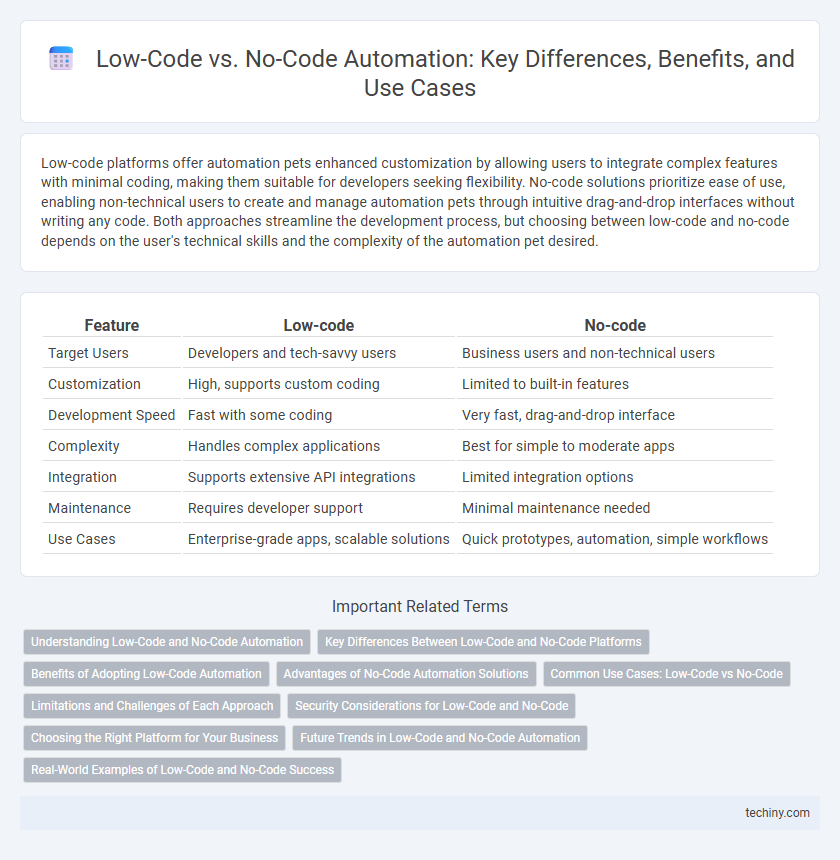Low-code platforms offer automation pets enhanced customization by allowing users to integrate complex features with minimal coding, making them suitable for developers seeking flexibility. No-code solutions prioritize ease of use, enabling non-technical users to create and manage automation pets through intuitive drag-and-drop interfaces without writing any code. Both approaches streamline the development process, but choosing between low-code and no-code depends on the user's technical skills and the complexity of the automation pet desired.
Table of Comparison
| Feature | Low-code | No-code |
|---|---|---|
| Target Users | Developers and tech-savvy users | Business users and non-technical users |
| Customization | High, supports custom coding | Limited to built-in features |
| Development Speed | Fast with some coding | Very fast, drag-and-drop interface |
| Complexity | Handles complex applications | Best for simple to moderate apps |
| Integration | Supports extensive API integrations | Limited integration options |
| Maintenance | Requires developer support | Minimal maintenance needed |
| Use Cases | Enterprise-grade apps, scalable solutions | Quick prototypes, automation, simple workflows |
Understanding Low-Code and No-Code Automation
Low-code automation platforms enable developers to create applications using minimal hand-coding, accelerating deployment while retaining customization capabilities. No-code automation tools empower non-technical users to build workflows through drag-and-drop interfaces, simplifying process automation without programming knowledge. Both approaches reduce development time and increase operational efficiency but cater to different user skill levels and project complexities.
Key Differences Between Low-Code and No-Code Platforms
Low-code platforms offer a blend of visual development and custom coding, enabling professional developers to build complex applications faster with reduced hand-coding. No-code platforms prioritize ease of use with drag-and-drop interfaces, empowering non-technical users to create applications without writing any code. Key differences lie in customization flexibility, target users, and scalability, with low-code favoring more control for developers and no-code emphasizing simplicity for business users.
Benefits of Adopting Low-Code Automation
Low-code automation accelerates application development by enabling users with minimal coding skills to create customized workflows and integrate complex systems efficiently. This approach reduces dependency on IT teams, cuts development costs, and allows for rapid scalability across business processes. Enhanced flexibility and better control over automation logic make low-code platforms ideal for organizations seeking tailored solutions without extensive coding expertise.
Advantages of No-Code Automation Solutions
No-code automation solutions empower users with no programming skills to create workflows and integrate systems quickly, reducing dependency on IT departments. These platforms accelerate deployment times by offering intuitive drag-and-drop interfaces and pre-built templates, which streamline business process automation. Cost savings arise from minimizing the need for specialized developers and enabling faster adaptation to changing business needs.
Common Use Cases: Low-Code vs No-Code
Low-code platforms excel in applications requiring complex workflows, integrations, and customization, such as enterprise software development, customer relationship management (CRM) systems, and supply chain automation. No-code tools are ideal for simpler, rapid application development tasks like building marketing websites, internal dashboards, and automated approval processes without the need for extensive programming knowledge. Both low-code and no-code solutions streamline automation by enabling faster deployment, but their use cases diverge based on the technical complexity and customization demands of the project.
Limitations and Challenges of Each Approach
Low-code platforms require some coding knowledge, making them less accessible for non-developers and potentially leading to integration complexities with existing systems. No-code tools offer simplicity but face limitations in customization, scalability, and handling complex workflows, restricting their use in larger enterprise environments. Both approaches may encounter challenges in security, vendor lock-in, and limited control over application performance, impacting long-term maintenance and flexibility.
Security Considerations for Low-Code and No-Code
Low-code and no-code platforms offer rapid application development with varying security implications; low-code solutions often provide more granular control over security protocols, enabling developers to implement advanced authentication and encryption measures. No-code platforms, while user-friendly, may introduce higher risks due to limited customization options for secure coding practices and dependency on vendor-managed security features. Proper evaluation of platform security capabilities, including compliance with standards like OWASP and GDPR, is crucial to mitigate vulnerabilities and ensure data protection in automated workflows.
Choosing the Right Platform for Your Business
Selecting the appropriate automation platform hinges on your business's technical capabilities and customization needs; low-code platforms offer more flexibility with minimal programming, suitable for businesses requiring tailored workflow automation. No-code platforms enable rapid deployment for users without coding skills, ideal for simple processes and quick iteration. Evaluating factors such as integration options, scalability, and user roles will ensure the chosen solution aligns with your operational goals and IT infrastructure.
Future Trends in Low-Code and No-Code Automation
Low-code and no-code automation platforms are evolving rapidly, integrating advanced AI capabilities to enhance customization and scalability. Future trends indicate increased adoption of these platforms across enterprises to accelerate digital transformation while reducing reliance on specialized developers. Emerging features like AI-driven workflow automation and seamless integration with IoT devices will further drive efficiency and innovation in business processes.
Real-World Examples of Low-Code and No-Code Success
Low-code platforms like Microsoft Power Apps enabled a global insurance firm to cut app development time by 70%, accelerating digital transformation with minimal coding. No-code tools such as Airtable helped a startup streamline inventory management without technical expertise, boosting operational efficiency by 40%. These real-world examples demonstrate how low-code and no-code solutions drive automation, reduce IT bottlenecks, and empower business users across industries.
Low-code vs No-code Infographic

 techiny.com
techiny.com